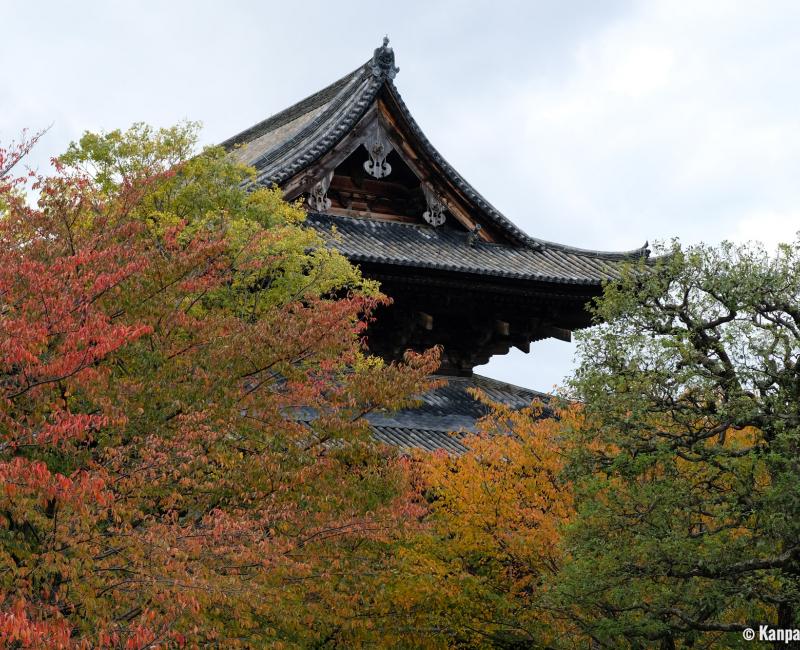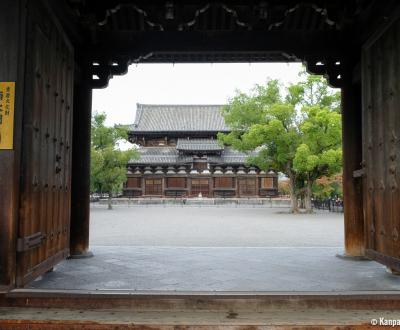To-ji
The Tallest Pagoda in Japan
To-ji is a Buddhist temple of the Shingon School, located in Minami ward, at the southwest exit of Kyoto station. Founded in 823 by Monk Kukai (Kobo Daishi), the complex is intended as the headquarters of his esoteric and tantric movement in the former imperial capital. Its impressive pagoda is enlisted in the Unesco World Heritage.
To-ji grounds feature several construction, of which Kodo and Kondo, located at the heart of the enclosure, are impressive. But the most remarkable is the 55-meters high, five-story pagoda, built in 1644. It is the tallest wooden tower in Japan, and stands like a lighthouse in the urban sea. The majestic building was included in the Unesco World Heritage List in 17 December 1994.
The central gate Nandaimon opens on To-ji’s grounds and a vast plaza that offers a first sight on the complex. The first building of importance is the main hall Kondo. It was destroyed on several occasions and the current construction dates back to 1603. After walking on the building’s left side, behind Kondo, discover a similarly massive building with red beams and pillars and white walls: the lecture hall Kodo, built in 1491.
Then the visit course leads to the ticket office, where those interested in the sacred enclosure can pay an entrance fee. However, most of the buildings (including Kukai’s former residence Miedo, located on the left hand on the western part of the temple) are free to access. That is where Kobo-ichi great flea market is held every 21 of the month, as well as an antique market every first Sunday of the month. The temple grounds are very lively on these days.
In 2021, from August 6 to September 19, the art collective teamLab set up an interactive light-up exhibition in To-ji’s grounds. A new permanent digital museum called teamLab Biovortex Kyoto opened in October 2025 in the temple's vicinity, about 2km away.

A remarkable collection of Japanese Buddhist art
Behind the metal fences, a pleasant small Japanese garden unravels, traditionally arranged with a pond at its center. On the other side, the two halls that were circumnavigated earlier, now open for contemplation of the numerous Buddhist images they shelter, although taking pictures inside is forbidden. In Kodo, there are no less than 21 wonderful statues of Nyorai, Bodhisattvas, Myoo and Tenbu that are either listed as Important Cultural Assets, or National Treasures of Japan. In Kondo, a statue of Yakushi Nyorai, the Buddha of medicine, is flanked by two other statues: Nikko Bosatsu and Gakko Bosatsu (respectively the Bodhisattvas of the sun and the moon).
Lastly the pagoda stands at the back of the small park, with no surrounding building that could put a shade on its height. Fascinating from afar, the tower is really impressive when considering it from its foot. First built in the 8th century, it was destroyed four times, of which once by thunder. Inside, around the central pillar, four statues of Buddha are placed at each corner of the square room. This intriguing place is open to visitors’ view only a few times a year.
The traditional aspects of Kyoto station’s surroundings are seldom highlighted, but there are nonetheless beautiful settings for those who stay or even just transit in the area. At least half a day is necessary to discover To-ji at the south exit, combined with the visits of Higashi-Hongan-ji temple, and above all Nishi-Honganji, easily accessible from the main northern entrance of the station.

